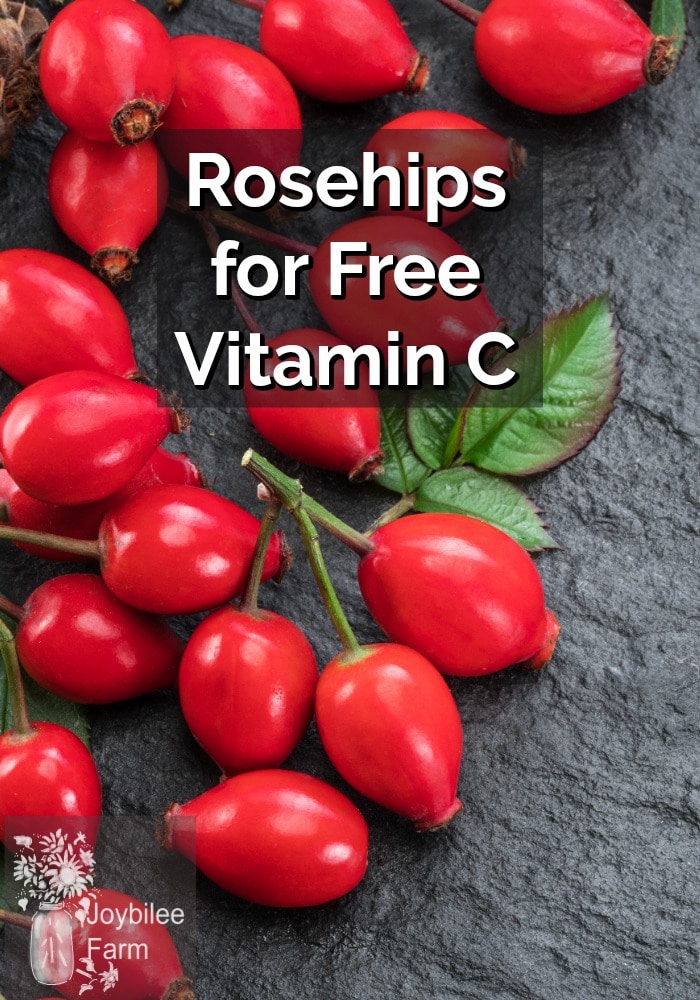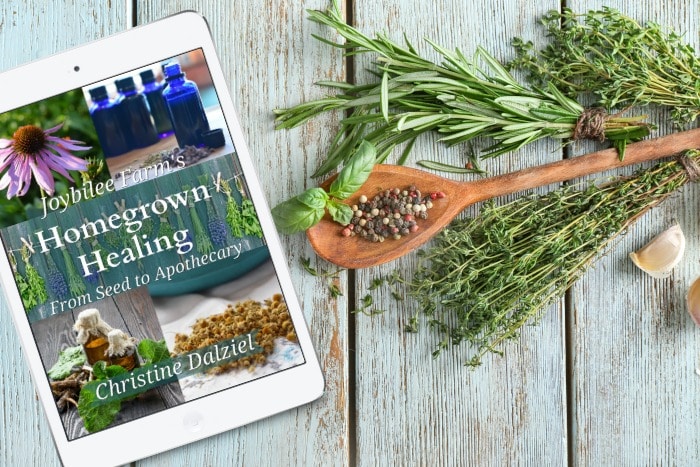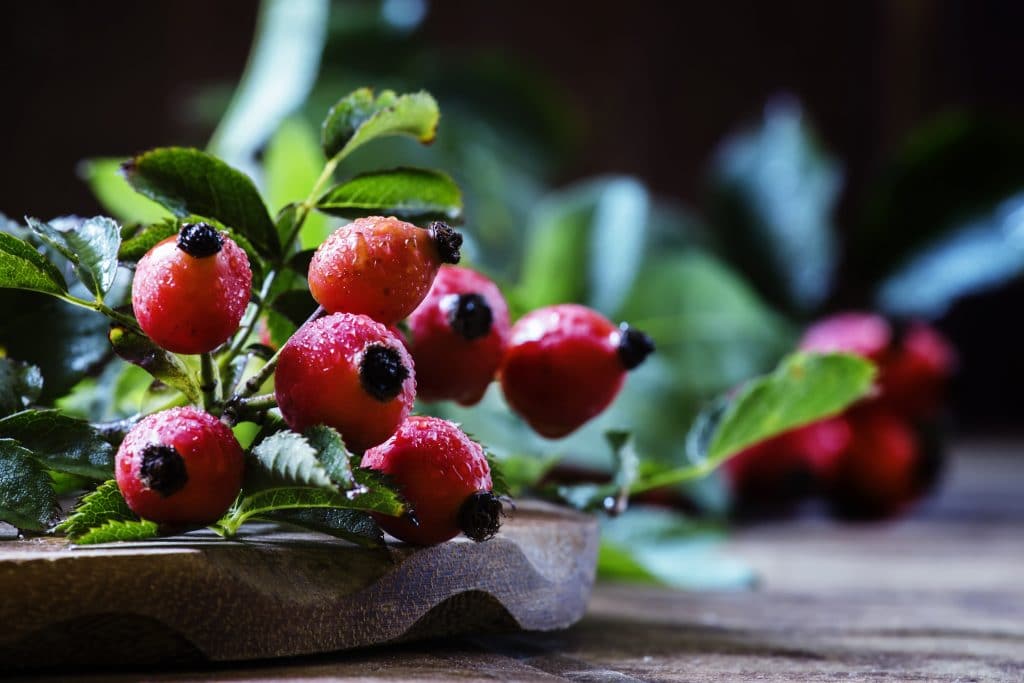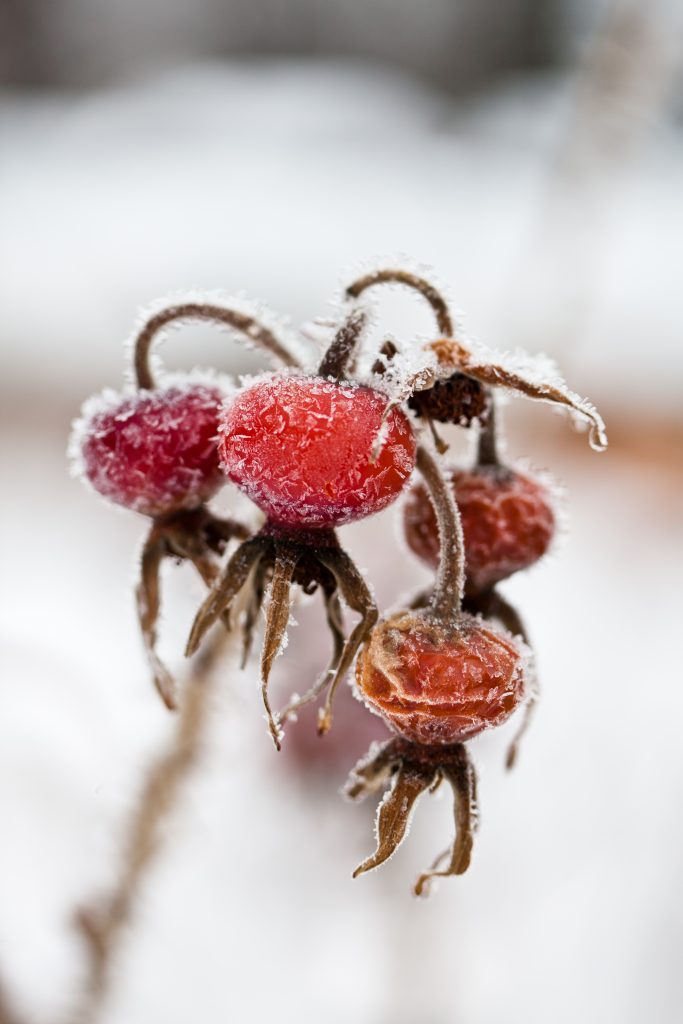Whether you grow your own roses or harvest from prolific wild roses, rosehips are a great source of natural vitamin C. Add fresh rosehip vitamin C to your winter teas, zoom balls, and other concoctions as an immune boost.
All roses develop fruit — hips — once the flowers fade. Wild roses and rugosa roses are the most prolific fruiting roses. Since they haven’t been selectively bred to convert their stamens into petals like many ornamental roses.

Health Benefits of Rosehips
Rosehips are rich in vitamin C, one of the highest plant sources, with 100 grams of dried hips yielding 2,000 mg of vitamin C. Rosehips contain vitamin A and B and the antioxidant lycopene, also found in tomatoes. Rosehips are also anti-inflammatory, immune-boosting, and anti-oxidant, making them beneficial for the treatment of arthritis, colds and flu. They are useful as a Spring tonic and for general debility and exhaustion. They help in cases of constipation and mild gall bladder problems. (Hoffman. Holistic Herbal, Rockport: Element Books, Inc, 1996. p. 135)
Their benefits can be gained by using them in tea, adding the dried, powdered fruit to baking, or making syrup.
Harvesting Rose Hips
Roses are related to apples and quinces. Rosehips are gathered in the Fall, after the first frost. They will be orange to red on the rose bushes and should be firm and plump. Some varieties of roses have darker hips from purple to almost black. Leave the shrivelled ones on the bush for the wild birds.
Rose seed itching powder (don’t add to your food)
The seeds inside the rosehips should be removed if you intend to use them as fruit or in tea. The seeds have minute hairs that irritate the skin. My friend, Wendy, from Holland, told me that while walking to school, the other children would pick rosehips, remove the seeds and put them down the backs of friends to induce itching. Thankfully, she outgrew that practice before she met me. Itching powder is made from dried and ground rose seeds.
Drying Rosehips for tea
If you intend to use the hips, whole in the tea you can leave the seeds in. If you are going to grind the hips before making tea, remove the seeds. To remove the seeds, after picking, remove the blossom end and discard. Cut the hips in half, scoop out the seeds. You can dry the cleaned hips for later use as tea, or cooking. Rosehips add a lemony taste to food, as well as the valuable rosehip vitamin C.
To dry the rosehips, I put them in a basket, lined with a paper towel and place them in a warm, airy spot in the kitchen, near the woodstove. I stir them frequently with my hand as I walk past. You can also dry them in a food dehydrator on low heat. But you don’t need a food dehydrator to be successful.
Rosehip Syrup for vitamin C
Or you can make rosehip jam or rosehip syrup to use during the winter. During WWII, when the German U-boats were preventing mercantile ships, with citrus fruit, from reaching Great Britain, the citizens of Britain were encouraged to gather wild rose hips and make vitamin C syrup for their children. Rosehip syrup retains the vitamin C content of rosehips for up to 9 months, even after preserving.
Recipe: Rosehip Syrup for vitamin C
– makes 3 pints
(adapted from Adventures in Cooking, BC Women’s Institutes, 1958).
- 4 cups of prepared fresh rosehips with blossom end removed, about 1 kg. (no need to remove seeds)
- 6 cups boiling water
- 1 cup of cane sugar
Boil for 2 minutes. Drain through a jelly bag. Reserve the liquid.
Add sugar to the resulting liquid. Bring to boil. Bottle in sterilized jars. Process 10 minutes to complete seal.
Use 1 tbsp. daily for vitamin C supplement.
Recipe: Rosehip Jam
- 4 cups prepared rosehips
- 1 organic orange
- Juice and zest of two organic lemons
- 1 large green apple, peeled, cored and chopped
- 5 cups cane sugar (beet sugar may be genetically modified)
- 1/2 cup homemade pectin
- 5 1/2 cups water
- 1/4 tsp. butter or coconut oil to reduce foaming
Leave the peel on the orange and slice and chop into 1/4 inch wedges, removing seeds. Add to an 8-quart pot, along with prepared rosehips, lemon zest and juice, and apple pieces. Add water and pectin and bring to a boil. Add butter or coconut oil to reduce foaming. Boil hard for 30 minutes, until orange peels become translucent and the jell stage has been reached. Begin to test the jell at 20 minutes. When the jell stage is reached, remove it from heat and pour it into sterilized pint jars. Complete seals and process for 5 minutes in a boiling water bath to seal jars.
Yield: 6 to 7 pints.
I’m harvesting rosehips this afternoon and drying them for tea and for the Joybilee Farm limited edition Wild Roses and Goat’s Milk Soap.
Your turn:
What’s your favourite use of roses? What hinders you from harvesting your own herbs for medicinal and culinary use? What would help you overcome this hindrance? Leave a comment.
If there is a topic you want to see articles about leave a suggestion in the comments section. I want this blog to be as helpful as possible to you.
Print
Rosehip Syrup
- Prep Time: 30 min
- Cook Time: 30 min
- Total Time: 60 min
- Yield: 2-3 pints 1x
Description
Use rosehips for an extra vitamin boost through syrups, tea, or jam.
Ingredients
- 4 cups of prepared fresh rosehips with blossom end removed, about 1 kg. (no need to remove seeds)
- 6 cups boiling water
- 1 cup sugar
Instructions
- Boil for 2 minutes.
- Drain through a jelly bag.
- Reserve the liquid.
- Add sugar to resulting liquid.
- Bring to boil.
- Bottle in sterilized jars.
- Process 10 minutes to complete seal in a hot water bath, or pressure canner
Notes
Use 1 table spoon as a vitamin C supplement, or add to normal tea as a sweetener and to add flavor.

Rosehip Jam
- Prep Time: 30 min
- Cook Time: 60 min
- Total Time: 90 min
- Yield: 6-7 pints 1x
Description
Rosehips as a tangy jam.
Ingredients
- 4 cups prepared rosehips (stem, blossom end, and seeds removed)
- 1 organic orange
- Juice and zest of two organic lemons
- 1 large green apple, peeled, cored and chopped
- 5 cups cane sugar
- 1/2 cup homemade pectin
- 5 1/2 cups water
- 1/4 tsp. butter or coconut oil to reduce foaming
Instructions
- Leave the peel on the orange and slice and chop into 1/4 inch wedges, removing seeds.
- Add to an 8 quart pot, along with prepared rosehips, lemon zest and juice, and apple pieces.
- Add water and pectin and bring to a boil.
- Add 1 tsp butter or coconut oil to reduce foaming.
- Boil hard for 30 minutes, until orange peels become translucent and jell stage has been reached.
- Begin to test the jell at 20 minutes.
- When jell stage is reached, remove from heat and pour into sterilized pint jars.
- Complete seals and process for 5 minutes in a boiling water bath to seal jars.
Learn more about using herbs for health and wellness from my Book

Homegrown Healing From Seed to Apothecary
My book Homegrown Healing From Seed to Apothecary will help you grow healing herbs in your own garden. Focusing on the easiest plants for beginners to grow, Homegrown Healing From Seed to Apothecary covers 30 plants, recommended by professional herbalists, that can be grown in the temperate zone. Initial garden preparation, garden design and harvesting tips lead the novice herbalist into early success. Choose which herbs to grow, learn how to use these herbs for your family’s health and wellness using the guidance in my book. You can find out more about this useful guide to growing more herbs and using them strategically here.






Besides eating & drinking tea I dry them, infuse them in my favourite carrier oil for about 6 weeks then filter the oil that I use all over my skin
Absolutely
Thank you for these recipes. I am so excited and looking forward to making them. Could I use honey for the syrup? I am trying to incorporate honey in my daily diet. Thanks so much.
The size of rose hips is dependent on the variety of rose and on the amount of water that the rose receives. Your small hips might be normal for that variety of rose.